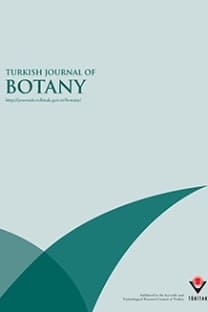New records of lichens and lichenicolous fungi for Russia and the Caucasus
Key words: Ascomycota, lichens, lichenicolous fungi, new records, Caucasus, Daghestan, Russia
New records of lichens and lichenicolous fungi for Russia and the Caucasus
Key words: Ascomycota, lichens, lichenicolous fungi, new records, Caucasus, Daghestan, Russia,
___
- Andreev M, Kotlov Y & Makarova I (1996). Checklist of lichens and lichenicolous fungi of the Russian Arctic. Bryologist 99: 137- 169.
- Atienza V & Hawksworth DL (2008). Lichenothelia renobalesiana sp. nov. (Lichenotheliaceae), for a lichenicolous ascomycete confused with Polycoccum opulentum (Dacampiaceae). Lichenologist 40: 87-96.
- Barkhalov SO (1983). Flora lishajnikov Kavkaza (Th e Lichen Flora of Caucasus). Baku: Elm Press (in Russian).
- Calatayud V & Triebel D (2003). Th ree new species of Stigmidium s.l. (lichenicolous ascomycetes) on Acarospora and Squamarina. Lichenologist 35: 103-116.
- Candan M & Özdemir-Türk A (2008). Lichens of Malatya, Elazığ and Adıyaman provinces (Turkey). Mycotaxon 105: 19-22.
- Clauzade G & Roux C (1985). Likenoj de Okcidenta Europo. Ilustrita determinlibro. Bulletin de la Société Botanique du Centre- Ouest, Nouvelle série numéro spécial 7: 1-893.
- Clauzade G, Diederich P & Roux C (1989). Nelikeniğintaj fungoj likenloĝaj. Ilustrita determinlibro. Bulletin de la Société Linneenne de Provence numéro spécial 1: 1-142.
- Flakus A, Ahti T, Kukwa M & Wilk K (2008). New and interesting records of Cladonia and their lichenicolous fungi from the Andean cloud forest in Bolivia. Ann Bot Fenn 45: 448-454.
- Halıcı MG (2008a). A key to the lichenicolous Ascomycota (including mitosporic fungi) of Turkey. Mycotaxon 104: 253-286.
- Halıcı MG (2008b). Some lichen records from Çat Forests (Gemerek, Sivas). Erciyes Üniversitesi Fen Bilimleri Enstitüsü Dergisi 24: 112-119.
- Halıcı MG & Aksoy A (2009). Lichenised and Lichenicolous Fungi of Aladağlar National Park (Niğde, Kayseri and Adana Provinces) in Turkey. Turk J Bot 33: 169-189.
- Hermansson J, Pystina TN, Owe-Larsson B & Zhurbenko MP (2006). Lishajniki i likhenofi lnye griby Pechero-Ilychskogo zapovednika (Lichens and lichenicolous fungi of Pechoro-Ilych reserve). Flora and Fauna of Reserves. Is. 109. Moscow: Commission on conservation of biodiversity of the Russian Academy of Sciences (in Russian).
- Kirk PM & Ansell AE (1992). Authors of fungal names. [Index of Fungi Supplement]. Wallingford: CAB International.
- Milanovsky YY & Khain VE (1963). Geoloicheskoe stroenie Kavkaza (Geological structure of the Caucasus). Moscow: Moscow University (in Russian).
- Muggia L, Grube M & Tretiach M (2008). A combined molecular and morphological approach to species delimitation in black-fruited, endolithic Caloplaca: high genetic and low morphological diversity. Mycol Res 112: 36-49.
- Murtazaliev RA (2008). Preliminary results of inventory of Daghestan fl ora. In: Fundamental and applied problems of botany in the XXI century beginning. Part 3, Petrozavodsk: Karelian Research Center of the Russian Academy of Sciences (in Russian), pp. 179-181.
- Oxner AN (1974). Handbook of the lichens of the U.S.S.R. Leningrad: Nauka (in Russian).
- Räsänen V (1939). Die Flechtenfl ora der nördlichen Küstengegend am Laatokka-See. Ann Bot Soc Zool-Bot Fenn “Vanamo” 12(1): 1-240.
- Seaward MRD, Sipman HJM & Sohrabi M (2008). A revised checklist of lichenized, lichenicolous and allied fungi for Iran. Sauteria 15: 459-520.
- Sedelnikova NV (2001). Lishajniki Zapadnogo i Vostochnogo Sajana (Lichens of the Western and Eastern Sayan Mountains). Novosibirsk: Siberian Branch of the Russian Academy of Sciences (in Russian).
- Silanez MEL, Etayo J & Paz-Bermudez G (2009). Pronectria pilosa (Hypocreaceae) sp. nov. and other lichenicolous fungi found on Collemataceae in the Iberian Peninsula. Bryologist 112: 101- 108.
- Smith CW, Aptroot A, Coppins BJ, Fletcher A, Gilbert OL, James PW & Wolseley PA (eds.) (2009). Th e Lichens of Great Britain and Ireland. London: British Lichen Society.
- Takhtajan AL (1986). Floristic regions of the world. Berkeley, Los Angeles: University of California Press.
- Timdal E (1991). A monograph of the genus Toninia (Lecideaceae, Ascomycetes). Opera Botanica 110: 1-137.
- Tretiach M & Muggia L (2006). Caloplaca badioreagens, a new calcicolous, endolithic lichen from Italy. Lichenologist 38: 223- 229.
- Urbanavichus GP, Gabibova AR & Ismailov AB (2010a). New for Caucasus lichen records from Daghestan. Bulletin of Moscow Society of Naturalists Biological Series 115(3): 72-74 (in Russian).
- Urbanavichus GP, Gabibova AR & Ismailov AB (2010b). First records about lichenfl ora of Daghestan Reserve. Novosti Sistematiki Nizshikh Rastenii (Novitates Systematicae Plantarum non Vascularium) (St-Petersburg & Moscow) 44: 250-256 (in Russian).
- Urbanavichus GP, Ismailov AB & Gabibova AR (2010c). New species to the lichen fl ora of Russia from Daghestan. Botanicheskii Zhurnal (Botanical Journal) (Moscow & St-Petersburg) 95(7): 983-988 (in Russian).
- Wirth V (1995). Die Flechten Baden-Württembergs. Teil 1-2. Stuttgart: Ulmer.
- Zhurbenko MP (2009). Lichenicolous fungi and lichens from the Holarctic. Part II. Opuscula Philolichenum 7: 121-186.
- ISSN: 1300-008X
- Yayın Aralığı: 6
- Yayıncı: TÜBİTAK
Çekerek’ten (Yozgat/Türkiye) yeni bir tür Silene hamzaoglui (Caryophyllaceae)
New records of lichens and lichenicolous fungi for Russia and the Caucasus
Gennadii URBANAVICHUS, Aminat GABIBOVA, Aziz ISMAILOV
New Ascomycete records for the macrofungi of Turkey
Hakan ALLI, Mustafa IŞILOĞLU, Mehmet Halil SOLAK
A new Onosma (Boraginaceae) species from southern Anatolia, Turkey
Verbascum ergin-hamzaoglui (Scrophulariaceae), a new species from South Anatolia, Turkey
Sezgin ÇELİK, Birol BAŞER, Ahter YAVRU, Faik Ahmet KARAVELİOĞULLARI
Ultrastructural localisation of chromium in Ocimum basilicum
Roya BISHEHKOLAEI, Hamid FAHIMI, Sara SAADATMAND, Taher NEJADSATTARI
The leaf anatomy of naturally distributed Juniperus L. (Cupressaceae) species in Turkey
Ayşegül GÜVENÇ, M. Mesud HÜRKUL, Ali ERDEM
Additional macrofungi records from Trabzon province for the mycobiota of Turkey
İlgaz AKATA, Mehmet Gökhan HALICI, Yasin UZUN
Verbascum ergin-hamzaoglui (Scrophulariaceae), Türkiye’nin Güney Anadolu bölgesinden yeni bir tür
Faik Ahmet KARAVELİOĞULLARI, Sezgin ÇELİK, Birol BAŞER, Ahter YAVRU
